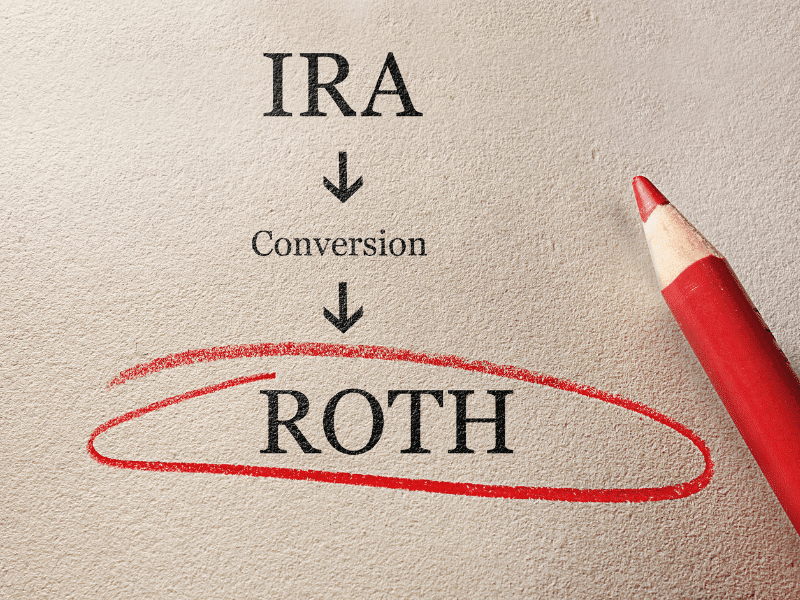Roth Conversions When The Market’s Down-7 Thoughts
When the stock market goes down, Roth conversions start looking more attractive to account owners. In this article, we’ll walk through 7 considerations about doing a Roth conversion when the market’s down.
Contents
Introduction
The fact is that a bear market can be a fleeting opportunity. For example, this article was first written in April 2020, during the coronavirus downturn. This downturn came at the end of a record bull market.
The silver lining was that was the best time to convert invested assets in over a decade. But by the end of the year, a nice quick rebound made asset values go back up, and that opportunity vanished.
At the time of this writing, we’re dealing with significant inflation for the first time since the 1980s, Russia has invaded Ukraine, and interest rates are set to go up (who knows how much). As a result, the S&P 500 is down 10% on the year.
It might be a good time to do Roth conversions. Or a great time.
But by the time you read this, it could be worse. Or we might have recovered. Or we might be on to the next crisis. Whatever happens, market downturns present a great opportunity to convert more of your retirement savings into Roth assets.
This article aims to help explain the benefits of doing a Roth IRA conversion in a down market. We’ll also outline 7 things you should consider when doing so, especially for the first time.
Benefits of Roth Conversions in a Down Stock Market

Let’s assume that you’ve made the decision to start doing Roth conversions. We’ll set aside the debate on whether to Roth or not to Roth for another day.
Usually, people have a certain dollar amount in mind. This makes sense, because you can estimate the tax liability on that conversion.
With a certain dollar amount, you might be able to convert a given number of shares of mutual funds. Given that, the argument is that when the stock market declines, you can convert more shares of that investment at the fixed dollar amount you’re paying income taxes today on.
Here’s an example
For example, let’s say you’re converting $9,000 of ABC stock this year. Originally, the stock was trading at $100 per share. So your conversion would consist of 90 shares of ABC stock (assuming you’re paying the conversion taxes with outside money).
But the stock market went down 10% before you did the conversion. Now your ABC stock is trading at $90 per share. So for $9,000, you can convert 10 extra shares of stock (or 100 shares total).
Then the stock market eventually recovers. The appreciation on these additional Roth IRA assets results in additional tax-free growth. Eventually, qualified distributions on these additional converted assets will be tax-free.
Tax-free withdrawals. Not a bad idea.
The numbers work. The math works. But it’s not as simple as that.
In fact, here are seven things you should consider if you’re looking to do a Roth conversion in a down market.
1: This should be a part of your overall Roth conversion strategy, not just a one-off decision.
If this is an idea that just came into your head when the stock market started declining, you might want to take a step back. You should think about how this fits in the bigger picture.
For example, if you’re in the 37% tax bracket (the highest tax bracket), it probably doesn’t make sense to do any Roth conversions right now. Odds are, you’re going to be in a lower tax bracket in the future.
Or perhaps it makes perfect sense if future income tax rates look to be higher than current tax rates. The fact is, you don’t really know if this conversion is a one-off idea that you’re trying to sandwich in between a variety of other tasks.
Most likely, if you’ve accumulated a significant amount in your retirement plans, then converting everything in a given year will create a MUCH higher tax bill.
Your tax planning deserves a more focused effort than this. Think about your approach to Roth conversions, use it to develop a long-term strategy, and then incorporate this year’s opportunity into that plan.
2: Asset location is key.
Once you decide how much money you’d like to convert, then you’ll want to be mindful of asset location. You might have heard of asset allocation, which is when you decide what to invest in (stocks, bonds, cash, etc.).
Asset location is a little different. You can think of it as a tax-focused ‘next-step.’ Asset location recognizes the tax treatment of different investments, and identifies the type of account that best complements that tax treatment.
While we look at the types of accounts and the investments that might go into them, please understand this is a very big-picture view—not intended as specific investment advice.

Investments that should go into a traditional IRA
Since a traditional IRA account is a tax-deferred account, it’s a good place for items that would result in ordinary income today.
For example, CDs or corporate bonds generate interest income. Interest income is taxed at higher rates than capital gains. If you had a choice between putting interest-earning investments in a taxable account or a traditional IRA, you would want to choose the latter.
Investments that should go into a Roth IRA
Roth IRA accounts are great for investments which are expected to achieve out-sized returns over time.
Think aggressive stocks you expect to outperform the market. You want to make sure that all those investment gains turn into tax-free income in a Roth account.
Investments that should go into taxable accounts
You don’t want to pay taxes on anything at all. But you’re likely going to have to put something into a taxable account.
You might consider tax-free investments, like municipal bonds. If munis are part of your investment portfolio, they definitely don’t belong in a tax-advantaged account. Especially if you’re expecting to get the state income tax benefit of a municipal bond.
You also might look at dividend-paying stocks (also known as blue chips). Blue chips are attractive because qualified dividends are taxed at a preferred, lower tax rate. For the lowest tax brackets, these rates can be as low as 0%.
Another possibility would be low-cost index funds. These would be mutual funds or exchange-traded funds that invest in major stock indexes, like the S&P 500, Russell 2000 or the Wilshire 5000.
Again, this is painting with a broad brush. But the point is this: after your Roth conversion, you’ll want to make sure that your asset location is appropriate. You’ll also want to make sure that your asset allocation is aligned with your investment strategy.
Your financial advisor should help you with this, particularly since they should be helping you avoid any mistakes along the way (see #5 below).
3: Don’t get too fancy with the execution. Stay with the plan.
You built a Roth conversion plan. It doesn’t matter what the plan looks like.
Perhaps you decided to do some Roth conversions early in the year, then revisit later after you’ve talked with your accountant. Perhaps you’re going to do everything now.
Maybe you’ll wait until you talk with your financial advisor.
But unless something significantly changes, don’t get too cute. And definitely don’t get off track by watching the markets.
4: Don’t let market timing throw you off course.
What is market timing? It’s simply trying to figure out what the market is going to look like (near-term), then placing your bets accordingly. Like guessing the bottom of market corrections.
Long-term, the market is a little more simple. The stock market will continue to go up as long as humans keep creating value, inventing things, and building stuff.
And if you don’t believe that, then you might consider selling everything now and stocking up on bullets, bullion, and land with high ground to build on.

But trying to see where the stock market is going to be in a month, six months, or even a year—that’s a fool’s errand.
And if you’re waiting to execute on your Roth conversion because you want to ‘get more bang for your buck,’ then you might be sorely disappointed.
5: Mistakes are costly. Avoid them.
Doing the math on a Roth conversion is straightforward. Actually doing the Roth conversion might not be so simple.
Doing Roth conversions involves a lot of mechanics that you might not have accounted for. If you’re doing this yourself, you might be wondering:
- Does my online account allow me to transfer shares of my investments, or do I have to sell first, then transfer cash?
- Which investments do I transfer (or liquidate so I can transfer cash)?
- What paperwork is required to do this?
- Do I need to open a new account?
And along the way, there are any number of simple mistakes that can cost you. For example, a fat-finger error could turn your $10,000 Roth conversion into a $100,000 taxable event. That becomes a huge tax burden.
And thanks to the Tax Cuts and Jobs Act of 2018 (TCJA), Roth conversions cannot be recharacterized. In plain English, a Roth conversion generally cannot be undone, especially if you were the one that pushed the ‘Confirm’ button.
You might ask your custodian, but you probably won’t get much help. Financial institutions usually don’t get involved in these events.
Your tax advisor might outline the options you have. But they’re probably going to be limited options that will end up costing a lot of money in fees and tax work.
The simplest way to avoid having to fix a mistake is to avoid making one in the first place.
6: Be mindful if you have both deductible and non-deductible IRA accounts.
According to the tax law, if you have both deductible (pre-tax) and non-deductible IRAs, then you have to recognize a prorated amount of your conversion from each account.
If you have only a pre-tax IRA (which most people have), then you’re expecting to pay taxes on the full amount. Conversely, if you have only a non-deductible IRA, then you’ve already paid taxes and don’t have to pay taxes again.
This generally occurs for high-earners who also contribute to an employer-sponsored plan. Because there are income limits, this makes them ineligible for directly contributing to a Roth IRA account, or deducting their traditional IRA contributions on their tax return.
Doing Roth conversions from a non-deductible IRA is also known as a backdoor Roth conversion.
If you have both accounts, you should understand that things can get tricky. So you might want to consider the tax consequences, based on your situation.
7: Keep track of ALL your taxable income
Not keeping track of income can cause your tax bill to go off track in a huge way. And the hardest thing is that retirement represents such a change in your cash flow that it’s hard to tell where your taxable income might come from.
Let’s imagine that you’ve planned your retirement for quite a while. You know that your W-2 income will stop when you retire. You’ve been planning for this for months, possibly even years.
You’ve got your monthly budget planned based on all the money you’re not going to spend. There are no more commuting costs, no more clothes that you have to buy for work, no more lunches at the office.
But then, you run into an emergency you didn’t expect, and you don’t have enough cash. No problem—sell some stocks, raise the money, and move on with the determination that you’ll do a better job next time.
Or maybe you’re looking to do some tax-loss harvesting. If you’ve accumulated shares of company stock over many years (like in a employee stock plan), the recordkeeping alone could be very daunting.
Well, depending on that stock sale, you could be facing a much higher tax bill. The thing is, unless you keep track of all of your taxable income, you just don’t know what the end of the tax year will look like.
You’ll eventually file for Social Security benefits. Perhaps, you’ll eventually take required minimum distributions. All of those add gross income that might disrupt your Roth conversion plan.
That’s why you have to account for these things in advance as you’re building your plan.
Conclusion
A stock market decline can be a great opportunity to do Roth conversions. You convert more shares of your investments for the same dollar amount that you might have when the stock market was going up. Then, as the stock market recovers, your investments appreciate tax-free.
Just be mindful of some of the considerations and pitfalls you might face when you actually start to do Roth conversions. That way, you don’t pay more in taxes than you’re expecting to.
If possible, go over your Roth conversion plan with your tax professional or your financial advisor.